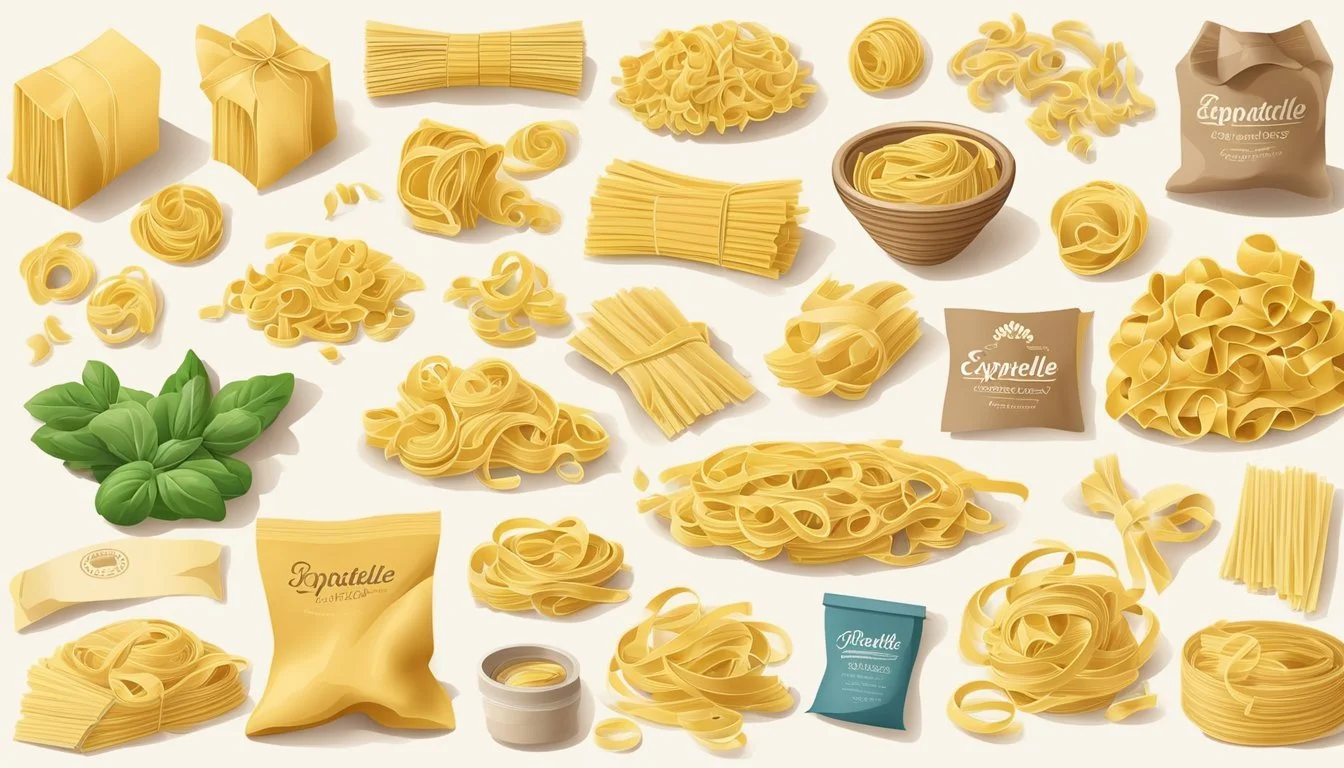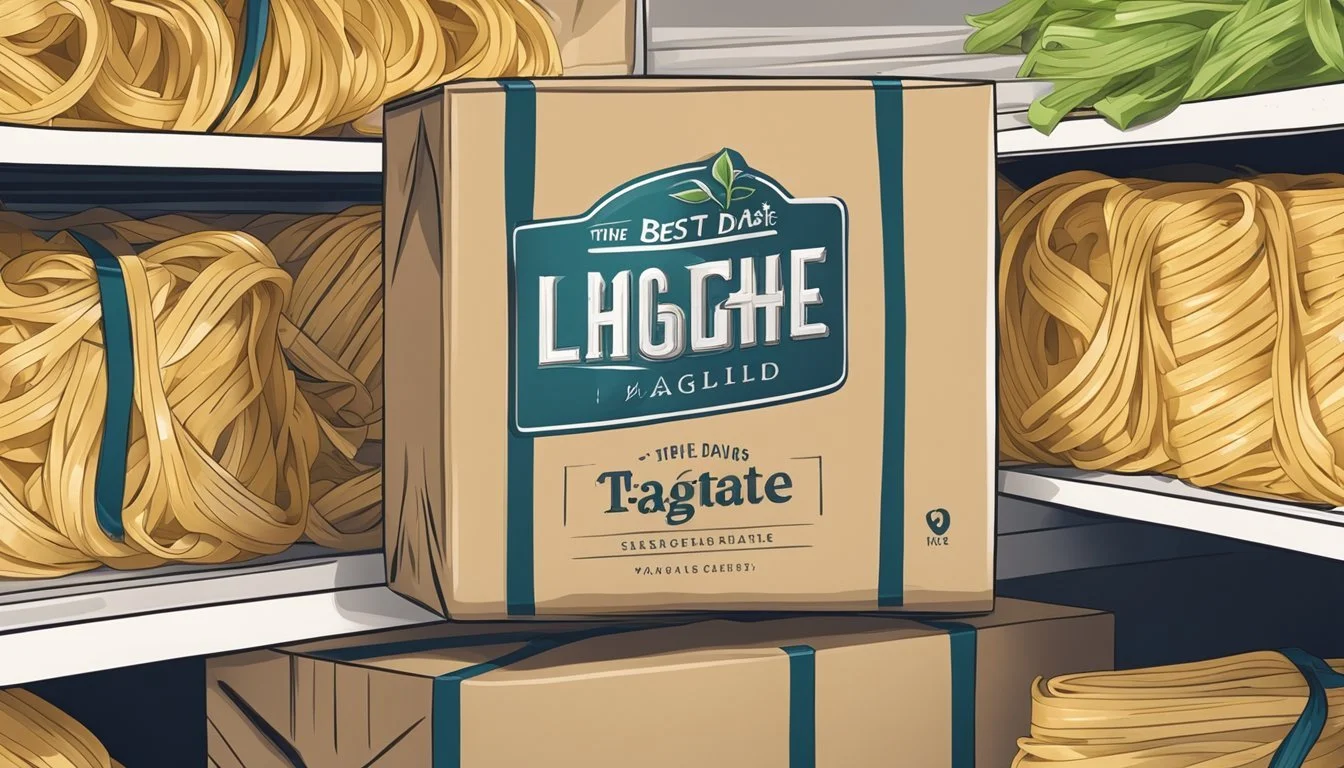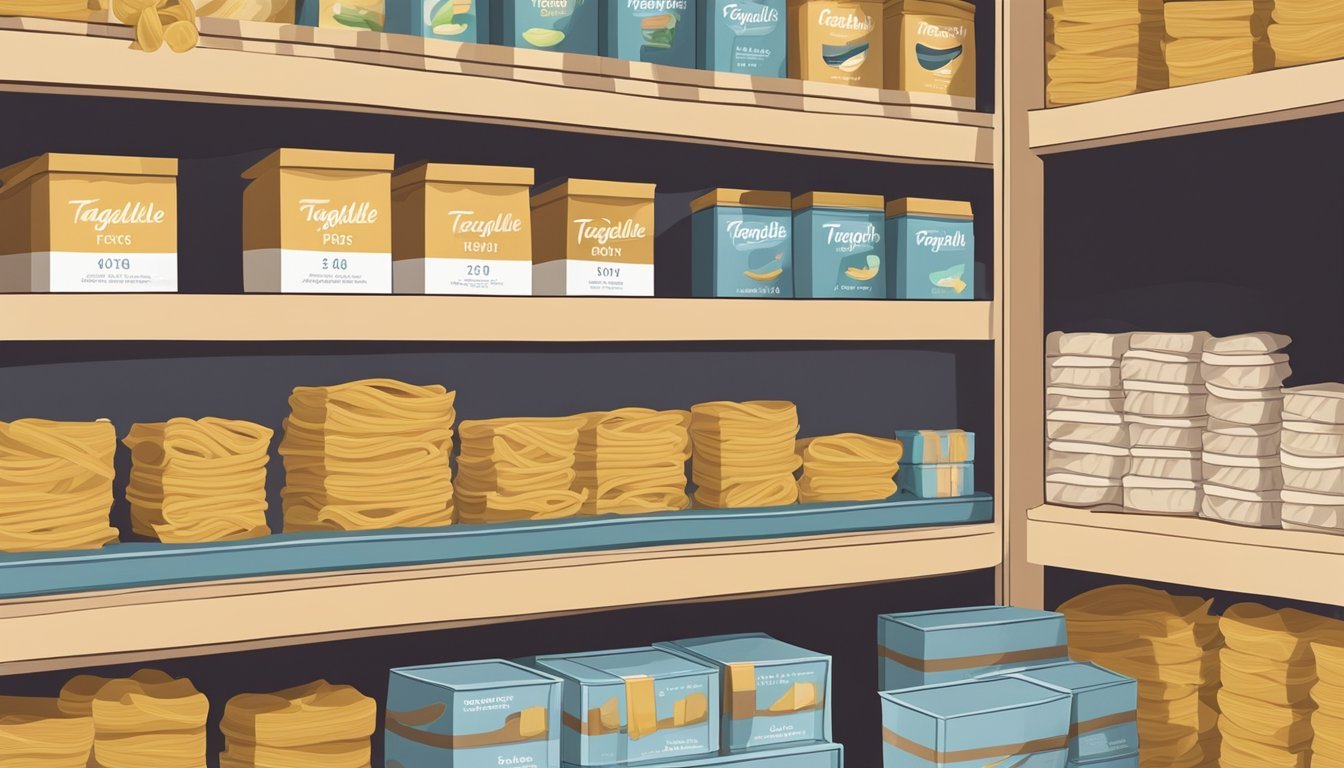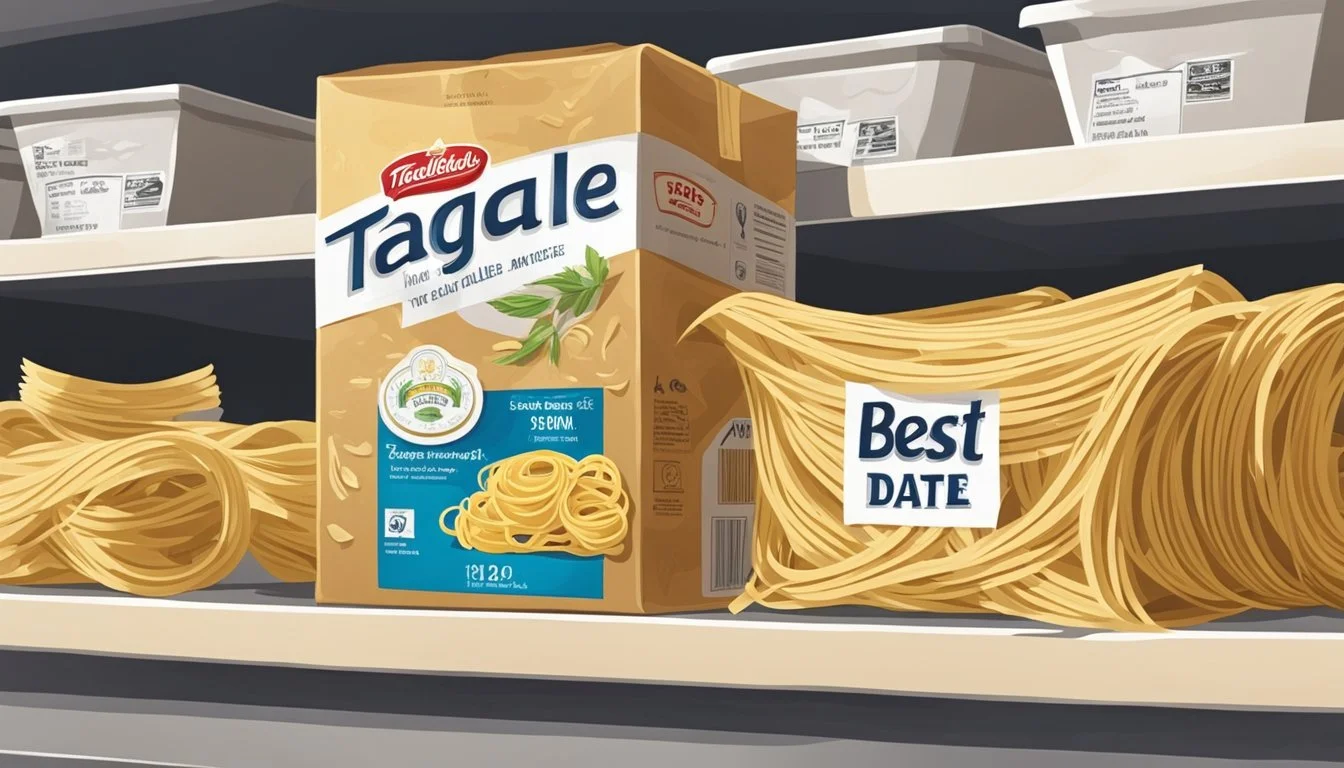How Long Does Tagliatelle Pasta Last?
Shelf Life and Storage Tips
When considering the longevity of tagliatelle pasta , it's essential to differentiate between its dry and fresh forms. Dry tagliatelle pasta (What wine goes well with pasta?), which is made from semolina flour (how long does semolina flour last?) and water, has a significant shelf life due to its low moisture content. In most cases, it can be stored for 1-2 years beyond its "best by" date without any notable change in quality. The durable nature of dried pasta makes it an ideal staple for long-term storage in the pantry.
Fresh tagliatelle pasta, on the other hand, has a much shorter lifespan. Typically, it will last for 4-5 days beyond its "best by" date when refrigerated. As fresh pasta (how long does fresh pasta last?) contains more moisture, it's more susceptible to mold and spoilage. It's crucial for those who favor the fresh variety to pay attention to storage methods and to consume the pasta in a timely fashion to ensure its optimal taste and texture.
Types of Tagliatelle Pasta
Tagliatelle pasta is a traditional staple of Italian cuisine with several variations, each offering different qualities and shelf lives. These variations include dried, fresh, and homemade tagliatelle, catering to diverse culinary preferences and storage considerations.
Dried Tagliatelle
Dried tagliatelle is typically made from durum wheat and water, sans egg, which allows it to have a longer shelf life. It is commercially produced through a process of extrusion and drying at low temperatures. Unopened, it can be stored in a cool, dry place and will last for approximately 1-2 years. Once cooked, dried tagliatelle should be consumed within 3-5 days when stored in the refrigerator.
Fresh Tagliatelle
Fresh tagliatelle, on the other hand, often includes eggs in addition to wheat, resulting in a more tender texture. Due to its moisture content, fresh pasta has a significantly shorter shelf life compared to dried pasta and should be consumed within a few days. It should be refrigerated and can last 4-5 days in the refrigerator. If one opts for gluten-free varieties, these too should be treated as fresh pasta due to their similar perishability.
Homemade Tagliatelle
Homemade tagliatelle is crafted from scratch using typically egg-based recipes, although gluten-free options can be made using alternative flours. Homemade pasta provides the freshest experience but also the shortest shelf life. It needs to be used within 1-2 days when stored in the refrigerator or can be dried and stored similarly to commercial dried pasta, extending its usability. Homemade dried pasta's shelf life can approximate that of the store-bought dried variety if properly processed and stored.
Storing Tagliatelle Pasta
Proper storage of tagliatelle pasta involves specific methods depending on whether it's dry, cooked but uneaten, or to be frozen for later use. Each method ensures maximum freshness and maintains the pasta's quality.
Dry Storage
For uncooked tagliatelle, the pantry is the ideal location. Dry pasta should be kept in an airtight container away from heat, light, and moisture. Under these conditions, it can last up to two years. Ensure the environment is cool, which typically means around room temperature, to prevent any compromises in quality.
Container: Use an airtight container.
Environment: Cool, dark, dry place.
Shelf-Life: Approximately two years.
Refrigerating Cooked Pasta
Once tagliatelle is cooked and not consumed immediately, it should be stored in the refrigerator within two hours of cooking to prevent bacteria growth. To properly store cooked pasta, one should use an airtight container or a sealable plastic bag. Drizzle a small amount of olive oil to prevent sticking. Refrigerated cooked tagliatelle can last approximately 3-5 days.
Container: Airtight container or plastic bag.
Additional steps: Add a small amount of oil to prevent sticking.
Shelf-Life: 3-5 days in the refrigerator.
Freezing Pasta
For longer storage, freezing cooked tagliatelle is an effective method. After cooling, portion the pasta into airtight containers or freezer bags. Before sealing, try to remove as much air as possible. Frozen pasta can last for up to two months. To use, defrost in the refrigerator or run under cool water before reheating.
Container: Airtight containers or freezer bags.
Air Removal: Essential to prevent freezer burn.
Shelf-Life: Up to two months in the freezer.
Shelf Life of Tagliatelle Pasta
Understanding the shelf life of tagliatelle pasta is crucial for maintaining its quality and safety for consumption. There are distinct differences between the longevity of dried and cooked pasta.
Shelf Life of Dry Pasta
Dried tagliatelle pasta, when stored properly in a cool, dry place, typically has a shelf life of up to 2 years beyond its expiration date. While it may not spoil after this time, the quality—such as taste and texture—might degrade. The shelf life for unopened dry pasta is fairly generous due to the low moisture content that inhibits the growth of microbes.
Expected shelf life: Up to 2 years beyond the 'best by' date
Optimal storage conditions: Cool, dry place away from direct sunlight
Quality indicators: Taste and texture may decline over time
Shelf Life of Cooked Pasta
Once tagliatelle pasta is cooked, its shelf life reduces significantly. Cooked pasta should be refrigerated within two hours of cooking, and it's safe to consume within 4-5 days when stored correctly at or below 40°F (4°C). Beyond this period, cooked pasta's quality can deteriorate, and there's an increased risk of foodborne illness from bacterial growth.
Expected shelf life: 4-5 days in the fridge
Optimal storage conditions: Airtight container at or below 40°F
Quality indicators: Presence of mold or an off smell indicates spoilage
By paying attention to these guidelines, one can ensure that both dry and cooked tagliatelle pasta are consumed within a safe and palatable time frame.
Factors Affecting Tagliatelle Longevity
When considering how long tagliatelle pasta lasts, it's crucial to account for the conditions under which it is stored. Moisture, temperature, and the method of preparation and handling all play significant roles in the preservation of this pasta.
Moisture and Humidity
Tagliatelle pasta's longevity is highly susceptible to moisture and humidity levels. Pasta should ideally be stored in a dry environment inside an airtight container to prevent it from becoming stale or developing mold. Fresh tagliatelle, which often contains eggs, is particularly sensitive to moisture and should therefore be consumed promptly or refrigerated.
Temperature and Light
The pasta's shelf life is also influenced by temperature and light exposure. Keeping tagliatelle in a cool, dark place, away from any direct sunlight, helps maintain its quality over time. For dry tagliatelle, a pantry or cupboard is typically sufficient. However, fresh tagliatelle, with its higher egg content, requires refrigeration to extend its shelf life.
Preparation and Handling
Proper preparation and handling contribute significantly to the lifespan of cooked tagliatelle pasta. Immediately adding a bit of olive oil after cooking can prevent sticking and spoilage. Seasoning with salt during the boiling process is not just for flavor; it also affects the texture and can play a minor role in preservation. After cooking and draining, if the pasta isn't consumed right away, it should be stored in the fridge within two hours to prevent microbial growth.
Recognition and Prevention of Spoilage
Recognizing when tagliatelle pasta has spoiled and taking steps to prevent spoilage are crucial to ensure both safety and quality. Adhering to proper storage techniques can help mitigate the risk of foodborne illness.
Identifying Spoiled Pasta
Spoilage in tagliatelle pasta can be detected by several indicators. Visual signs such as the presence of mold or any discoloration suggest that the pasta should not be consumed. When inspecting pasta, one should also check for:
Texture changes: Pasta that has become slimy or excessively sticky is indicative of bacterial growth.
Odor: A sour or off smell is a clear sign that pasta has gone bad.
Consuming spoiled pasta can lead to foodborne illness, as harmful bacteria may have proliferated in the food.
Preventing Pasta Spoilage
To minimize the risk of spoilage, tagliatelle pasta, which is a perishable food, should be stored appropriately. For leftovers, the following practices are recommended:
Refrigeration: Store in an airtight container and consume within 3–5 days.
Freezing: For longer shelf life, freeze in suitable containers for up to 2 months.
Maintaining a temperature below 40°F (4°C) hinders the growth of many foodborne pathogens, helping to preserve the texture and taste of the pasta while preventing spoilage and potential health risks.
Cooking and Reheating Techniques
To ensure the quality and texture of tagliatelle pasta, one must pay close attention to cooking it to al dente and select the appropriate reheating method.
Cooking Pasta to Al Dente
When cooking tagliatelle noodles, one should bring a large pot of salted water to a rapid boil. Cooking the pasta al dente, which means 'to the tooth' in Italian, is crucial for the perfect bite. This requires monitoring the pasta and tasting it a couple of minutes before the end of the cooking time stated on the package. Al dente pasta is firm to the bite and not overly soft. Additionally, to prevent sticking, stir the noodles occasionally and consider adding a small amount of oil to the boiling water if desired.
Best Methods for Reheating
Reheating tagliatelle without losing its texture is possible through several methods:
Boiling Water: Submerge noodles in boiling water using a heat-safe colander for about 30 seconds, then remove and combine with sauce.
Microwave: Place pasta in a microwave-safe dish, cover with a damp paper towel, and heat in short increments, stirring occasionally.
This technique preserves the al dente quality and prevents the noodles from becoming mushy. Reheating should be done only once to maintain the quality and safety of the pasta.
Usage and Serving Suggestions
Tagliatelle pasta is versatile, allowing for traditional and innovative culinary applications. Proper serving suggestions can enhance the taste and presentation of dishes featuring tagliatelle.
Tagliatelle in Traditional Dishes
Tagliatelle traditionally pairs well with rich, hearty sauces due to its wide, flat shape that holds onto sauces. A classic Bolognese sauce, with its robust meaty flavor, is the quintessential match for tagliatelle. Serving size per person usually ranges from 75 to 100 grams of dry pasta. For an authentic Italian experience, chefs suggest boiling fresh tagliatelle nests for 3-4 minutes for an 'al dente' texture, after which the pasta is typically rested briefly to ensure it retains its ideal consistency.
Creative Serving Ideas
Moving beyond traditional uses, tagliatelle can be incorporated into a variety of dishes to suit different tastes. For a lighter option, one could toss cooked tagliatelle with olive oil, garlic, and a mix of seasonal vegetables. To cater to dietary preferences, bean-based or gluten-free tagliatelle options can substitute traditional pasta. These alternatives can pair well with less conventional sauces such as those including rice or beans for added texture and nutrition, and may be garnished with cheese or herbs for added flavor. It's important, however, to note that gluten-free variants may have a shorter shelf life—typically 3-5 days in the fridge.
Special Considerations for Tagliatelle
When selecting or preparing tagliatelle, individuals must consider dietary restrictions and possibilities for ingredient substitutions to ensure the dish meets their specific needs.
Dietary Needs
Tagliatelle pasta typically contains gluten, as it is made from wheat flour. For individuals with gluten intolerance or celiac disease, gluten-free options should be sourced. These varieties often use alternative flours such as rice or corn flour (how long does corn flour last?). It's crucial to note that the texture of gluten-free tagliatelle can differ slightly from traditional wheat-based noodles.
The pasta also provides a moderate amount of protein, as traditional tagliatelle includes eggs in its ingredients. Consumers looking to understand the nutritional content should check for sugar levels, especially in flavored or pre-packaged tagliatelle varieties, as some may have added sugars.
Making Substitutes
When considering substitutes for tagliatelle due to dietary restrictions or personal preferences, one should be mindful of the pasta's characteristics. Tagliatelle is a long, ribbon-like noodle, which makes it suitable for hearty sauces.
Substitutes for Tagliatelle Comparison Fettuccine Slightly narrower than tagliatelle but can be used similarly for most recipes Linguine Narrower and often used with lighter sauces, but a viable substitute Gluten-free alternatives Made with substitute flours and vary in texture, but cater to gluten-intolerant diets
For homemade pasta, the dough can be extruded through a pasta machine to ensure uniformity in width. Extruded pasta, which is pasta shaped by being forced through a die, may not typically include tagliatelle, but it offers an alternative method for making gluten-free or other substitute pasta shapes.
Tagliatelle Pasta FAQs
How long does tagliatelle pasta last in the fridge?
Uncooked tagliatelle pasta can last in the fridge for 1-2 days if it is fresh. Once cooked, it can be refrigerated for 3-5 days in an airtight container.
Is it necessary to refrigerate tagliatelle?
Fresh tagliatelle should be refrigerated if not consumed within a few hours due to its egg content. Dry tagliatelle, however, can be stored in a pantry for a long time.
What is the origin of tagliatelle pasta?
Tagliatelle originates from Northern Italy. Its name comes from the Italian verb tagliare, meaning "to cut", which refers to the way the pasta is made, typically with a pasta machine.
How does tagliatelle differ from linguine?
Tagliatelle is wider than linguine. Traditionally, tagliatelle's width ranges from 6-8mm, whereas linguine is typically around 3mm wide.
Can tagliatelle be a source of iron?
Pasta such as tagliatelle made from durum wheat semolina can be a source of iron, though not as significant as meats or legumes.
How do you cook tagliatelle correctly?
For the perfect al dente bite, boiled fresh tagliatelle should be cooked in generously salted water for approximately 3-4 minutes. Taste before removing from the water to ensure it's done to your liking.











